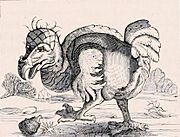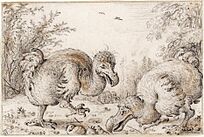Réunion ibis facts for kids
Quick facts for kids Réunion ibis |
|
|---|---|
 |
|
| An imagined picture of the Réunion ibis, based on old descriptions, subfossil bones, and its living relatives. | |
| Conservation status | |
| Scientific classification | |
| Genus: |
Threskiornis
|
| Species: |
solitarius
|
 |
|
| Location of Réunion (encircled) | |
| Synonyms | |
|
List
Apterornis solitarius Sélys, 1848
Raphus solitarius Sélys, 1848 Didus apterornis (Schlegel, 1854) Pezophaps borbonica Bonaparte, 1854 Ornithaptera borbonica (Bonaparte, 1854) Apterornis solitaria (Milne-Edwards, 1869) Didus borbonica (Schlegel, 1873) Didus borbonicus (Schlegel, 1875) Ornithaptera solitarius (Hachisuka, 1953) Victoriornis imperialis Hachisuka, 1937 Borbonibis latipes Mourer & Moutou, 1987 |
|
The Réunion ibis (Threskiornis solitarius) was a type of ibis that is now extinct. It lived only on the volcanic island of Réunion in the Indian Ocean. Scientists first found its subfossil bones in 1974. The bird was officially described in 1987.
This ibis was closely related to the Malagasy sacred ibis, the African sacred ibis, and the straw-necked ibis. People who visited Réunion in the 1600s and 1700s wrote about a white bird there. They said it had trouble flying and liked to be alone. Because of this, they often called it the "Réunion solitaire" (which means "solitary" or "lonely" bird).
For a while, people thought these old stories were about a white bird related to the dodo. This was because one story mentioned dodos on the island. Also, some old paintings of white dodos had recently been found. However, no dodo-like fossils were ever found on Réunion. It was later questioned if the paintings were even connected to the island.
In the late 1900s, finding ibis fossils changed everything. Scientists then realized that the old stories likely described an ibis, not a dodo. Most experts now agree that the "solitaire" and the ibis fossils are from the same bird.
Contents
About the Réunion Ibis
The Réunion ibis was a unique bird. It was mainly white, with hints of yellow and grey. Its wing tips and the feathers on its back were black, like an ostrich's plumes.
What it Looked Like
This ibis had a long neck and long legs. Its beak was fairly straight and shorter than what you might expect for an ibis. It was built stronger than its living relatives. However, it looked quite similar to them in other ways. The Réunion ibis was about 65 cm (25 in) long.
Scientists studied its wing bones. These bones show that the bird could not fly very well. This might have been because it got very fat during certain seasons.
What it Ate
The Réunion ibis found its food in the soil. It mostly ate worms and other small things it could dig up.
Why it Disappeared
In the 1600s, the Réunion ibis lived in the mountains. It might have moved to these high, remote areas because of too much hunting. People liked to eat its meat, saying it tasted very good. Also, new animals brought to the island, like cats or rats, might have hunted the ibis in easier-to-reach areas.
These problems led to the Réunion ibis becoming extinct. It is believed to have disappeared by the early 1700s.
History of its Discovery
The story of how scientists understood the Réunion ibis is quite complicated. For a long time, there wasn't much clear evidence.
The "White Dodo" Mistake
For many years, people thought there was a "white dodo" on Réunion. This idea came from a few old reports about the Réunion ibis. It was also mixed up with paintings of white dodos from Mauritius. These paintings were made by Dutch artists like Pieter Withoos and Pieter Holsteyn II in the 1600s. They became known in the 1800s.
Early Descriptions
The first person to mention a white bird on Réunion was an English officer named John Tatton in 1625. When the French took over the island in 1646, they called this bird the "solitaire."
M. Carré, from the French East India Company, described the "solitaire" in 1699. He explained why it was called that:
I saw a kind of bird in this place which I have not found elsewhere; it is that which the inhabitants call the Oiseaux Solitaire for to be sure, it loves solitude and only frequents the most secluded places; one never sees two or more together; it is always alone. It is not unlike a turkey, if it did not have longer legs. The beauty of its plumage is a delight to see. It is of changeable colour which verges upon yellow. The flesh is exquisite; it forms one of the best dishes in this country, and might form a dainty at our tables. We wished to keep two of these birds to send to France and present them to His Majesty, but as soon as they were on board ship, they died of melancholy, having refused to eat or drink.
The Rodrigues Solitaire Link
François Leguat, a French Huguenot who was left on an island, used the name "solitaire" for a different bird. This was the Rodrigues solitaire, a bird related to the dodo. He saw it on the nearby island of Rodrigues in the 1690s. However, he likely got the name from an earlier writing from 1689 that mentioned the Réunion bird. No actual Réunion "solitaire" birds were ever saved for study.
The two birds M. Carré tried to send to the king's animal collection in France did not survive. They died because they wouldn't eat or drink. One person claimed that a French leader sent a "solitaire" from Réunion to France around 1740. But since the Réunion ibis was probably extinct by then, this bird might have been a Rodrigues solitaire instead.
The Dodo Confusion
Only one writer, a Dutch sailor named Willem Ysbrandtszoon Bontekoe, specifically mentioned "dodos" on Réunion. He didn't say what color they were:
There were also Dod-eersen [old Dutch for dodos], which have small wings, and so far from being able to fly, they were so fat that they could scarcely walk, and when they tried to run, they dragged their under side along the ground.
When his travel journal was published in 1646, it included a picture. This picture was copied from a drawing of a dodo by the Flemish painter Roelant Savery. Bontekoe had lost all his things in a shipwreck after visiting Réunion in 1619. He might not have written his story until seven years later, after he returned home. This makes his memory less reliable. He might have thought what he saw was a dodo because it sounded similar to other dodo stories.




